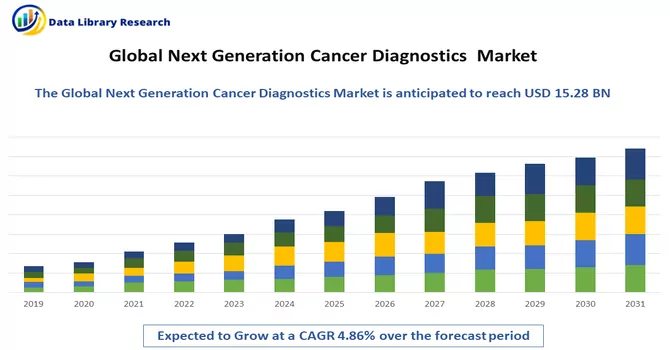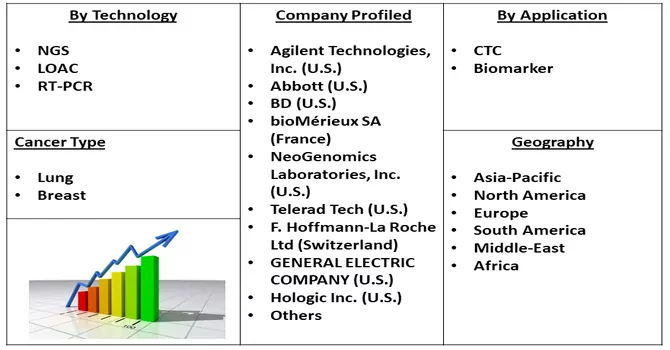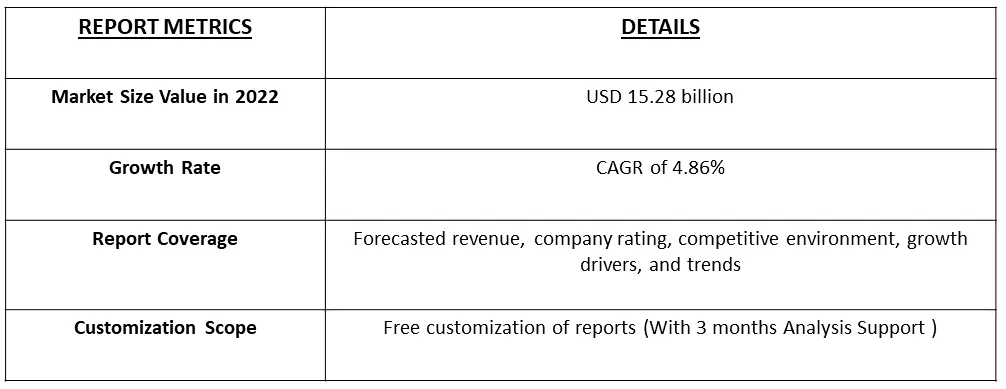The Next Generation Cancer Diagnostics Market is currently valued at USD 15.28 billion in the year 2022 registering a CAGR of 4.86% over the forecast period, 2023-2030.

Get Complete Analysis Of The Report - Download Free Sample PDF
The growth of the studied market is driven due to the rising incidence of oncology diseases, the need for efficient prognosis and early diagnosis of various forms of cancer, and rising initiatives by key players in the development of innovative solutions to meet the increasing demand for efficient diagnostics. Several tests, including physical examination, laboratory tests, imaging tests, and biopsies have traditionally been performed in cancer diagnosis. Each step of the usual diagnostic procedure with the prognosis and therapeutic decision made by oncologists comes with a well-defined diagnosis to avoid potential complications. This highlights the crucial importance of diagnosis throughout the entire oncology lifecycle, surpassing the therapeutic regime's significance.
In cancer research, NGS is often used to identify genetic variations and mutations. Researchers and clinicians use NGS to look at large portions of DNA and RNA at once. Then, they identify any abnormalities that could be related to the disease.
Segmentation:
The Global Next Generation Cancer Diagnostics Market is Segmented
By Technology
By Application
Cancer Type
Geography
The report offers market size and values in (USD million) during the forecasted years for the above segments.

For Detailed Market Segmentation - Download Free Sample PDF
Next-generation sequencing (NGS) allows for the sequencing of multiple genes at a very high depth of coverage. The principle of targeted therapy consists of the application of drugs targeted against well-defined molecules that play a key role in tumour progression and/or survival. Considering the continuous discovery of new molecules as a putative target or that are responsible for treatment resistance mechanisms, single-gene diagnostics is becoming less effective. At present, precision medicine requires multigene characterization. The introduction of NGS to molecular diagnostics has allowed us to combine high analytical sensitivity with multigene analysis.
Drivers: Increasing Cancer Cases
Next-generation sequencing (NGS) is a novel genetic diagnostic technique that is increasingly ordered by cancer specialists, although there is controversy about whether upfront full molecular profiling is needed in all patients with cancer. NGS offers advantages in accuracy, sensitivity, and speed that have the potential to make a significant impact on the field of oncology. Because NGS can assess multiple genes in a single assay, it eliminates the need to order multiple tests to identify the causative mutation. An article titled “Cancer Statistics, 2023” published by NCBI in January 2023, reported that in 2023, 1,958,310 new cancer cases are projected to occur in the United States. Furthermore, the data update by WHO in February 2022, reported that the most common in 2020 (in terms of new cases of cancer) were, breast (2.26 million cases), lung (2.21 million cases), colon and rectum (1.93 million cases), prostate (1.41 million cases), skin (non-melanoma) (1.20 million cases); and stomach (1.09 million cases). Thus, a high number of cancer cases is expected to contribute to the growth of the studied market.
Introduction Advanced Technology in NGS
In January 2023, QIAGEN entered into an exclusive strategic partnership with Helix to advance NGS companion diagnostics in hereditary diseases. The collaboration leverages the Helix Laboratory Platform, which is powered by QIAGEN's biopharma relationships, next-generation sequencing (NGS) capabilities, and global regulatory expertise. The combined offering of the partnership is anticipated to be accelerated by patient recruitment for the utilization of real-world evidence, and the provision of diagnostic solutions using NGS and PCR technologies. In addition, the ongoing advancements in NGS, liquid biopsies, and molecular imaging technologies have significantly improved the sensitivity, accuracy, and efficiency of therapeutic monitoring. For instance, in March 2022, the FDA granted approval for Novartis' Pluvicto for the treatment of progressive, PSMA-positive metastatic castration-resistant prostate cancer as the first targeted radioligand therapy.
Restraints:
Lack of skilled professionals
The lack of qualified personnel who are unable to use these diagnostics tests could curb the growth of the global enhanced ambulatory patient grouping software market over a forecast period.
Segmental Analysis:
Biomarker Segment is Expected to Witness Significant Growth Over the Forecast Period.
In biomedical contexts, a biomarker is a measurable indicator of some biological state or condition. Biomarkers are often measured and evaluated using blood, urine, or soft tissues to examine normal biological processes, pathogenic processes, or pharmacologic responses to a therapeutic intervention procedure. Biomarkers can be used to evaluate organ function by introducing traceable substances into the body.
The launch of biomarker tests by market players has contributed to the growth of this segment. For example, Labcorp introduced the Neurofilament Light Chain (NfL) blood biomarker test in July 20222. This test provides direct evidence of neurodegeneration and neuronal injury, enabling doctors to identify and verify signs of neurodegenerative diseases such as multiple sclerosis, Alzheimer’s, Parkinson’s, and brain injuries. Elevated NFL levels indicate neuronal injury and can aid in diagnosis and treatment decisions for patients. Thus, the segment is expected to witness significant growth over the forecast period.
Breast Cancer Segment is Expected to Witness High Growth Over the Forecast Period.
As per canceraustralia.gov.au, in 2021, 20,030 new breast cancer cases were diagnosed in the country (164 males and 19,866 females). The same source reports that in 2021, a person had an estimated 1 in 15 (or 6.7%) risk of being diagnosed with breast cancer by the age of 85 (1 in 8 or 13% for females and 1 in 829 or 0.12% for males). Therefore, the high burden of breast cancer is increasing the demand for breast cancer treatment, thereby contributing to the segment’s growth. Furthermore, as per an October 2021 update by the University of North Carolina's School of Medicine, Susan G. Komen, the world’s leading breast cancer organization, announced that it would award USD 1.5 million for three new research projects that examine three unique areas focused on metastatic breast cancer (MBC).
North America is Anticipated to Observe a Significant Growth in the Global Cancer Diagnostics Market
North America is projected to hold the largest share of the cancer diagnostics market by region. The region has observed a negative impact on the market due to the emergence of COVID-19.
According to the Union for International Cancer Controls (UICC), there was a significant decrease in cancer diagnostics rates in the United States during the pandemic. For instance, newly diagnosed metastatic non-small cell lung cancer patient volumes declined just over 30% from February 2020 to March 2020. Declines were also observed in colorectal cancer (14%), acute myeloid leukemia (14%), breast cancer (8.4%), and ovarian cancer (8.6%). These instances indicate a decline in the diagnosis rate of cancer during the pandemic era.
The key factors contributing to the market growth are the rising burden of cancer, the development of new products, and the rising awareness of the disease. Furthermore, as per the data provided by GLOBOCAN, 2020, about 2,281,658 new cancer cases were reported, with a 5-year prevalence of about 8,432,938 in the same year in the United States of America. Similarly, the National Cancer Institute (NCI) stated that the national spending on cancer care is expected to reach USD 156 billion by 2020.
Moreover, the launch of new products is expected to contribute to the studied market growth. For instance, in January 2020, the American Cancer Society and Pfizer approved grants totaling more than USD 2.5 million in nine communities focused on reducing racial disparities and helping optimize outcomes for women facing a breast cancer diagnosis. Thus, with these factors, the market is expected to flourish in North America.

Get Complete Analysis Of The Report - Download Free Sample PDF
Competitive Landscape:
The Next Generation Cancer Diagnostics Market is highly competitive due to the presence of many major players working globally and regionally. Some of the market players working in this market segment are:
Recent Developments:
1) In July 2023: Illumina Inc. and array-based technologies, and Pillar Biosciences Inc., the pioneers of Decision Medicine, reported a strategic partnership to make Pillar's suite of oncology assays commercially available globally as part of the Illumina portfolio of oncology products. The agreement will result in an unprecedented offering of complementary next-generation sequencing solutions that will enhance the efficiency, accuracy, and cost-effectiveness of oncology testing through advanced sequencing techniques, improving patient access to personalized cancer treatment options.
2) In May 2023: Pfizer and Thermo Fisher Scientific Inc. entered into a collaboration agreement to help increase local access to next-generation sequencing (NGS)-based testing for lung and breast cancer patients in more than 30 countries across Latin America, Africa, the Middle East and Asia where advanced genomic testing has previously been limited or unavailable. Access to local NGS testing can help to provide faster analysis of genes associated, empowering healthcare providers to select the right therapy for that individual patient.
Q1. What is the Growth Rate of the Next Generation Cancer Diagnostics Market?
Next Generation Cancer Diagnostics Market is registering a CAGR of 4.86% over the forecast period.
Q2. What is the current Next Generation Cancer Diagnostics Market size?
Next Generation Cancer Diagnostics Market is currently valued at USD 15.28 billion.
Q3. What are the factors on which the Next Generation Cancer Diagnostics market research is based on?
By Technology. By Application, By Cancer Type & Geography are the factors on which the Next Generation Cancer Diagnostics market research is based.
Q4. Which are the major companies in the Next Generation Cancer Diagnostics Market?
Agilent Technologies, Inc., Abbott, BD, bioMérieux SA are the few companies in the Next Generation Cancer Diagnostics Market.
Data Library Research are conducted by industry experts who offer insight on industry structure, market segmentations technology assessment and competitive landscape (CL), and penetration, as well as on emerging trends. Their analysis is based on primary interviews (~ 80%) and secondary research (~ 20%) as well as years of professional expertise in their respective industries. Adding to this, by analysing historical trends and current market positions, our analysts predict where the market will be headed for the next five years. Furthermore, the varying trends of segment & categories geographically presented are also studied and the estimated based on the primary & secondary research.
In this particular report from the supply side Data Library Research has conducted primary surveys (interviews) with the key level executives (VP, CEO’s, Marketing Director, Business Development Manager and SOFT) of the companies that active & prominent as well as the midsized organization
FIGURE 1: DLR RESEARH PROCESS

Extensive primary research was conducted to gain a deeper insight of the market and industry performance. The analysis is based on both primary and secondary research as well as years of professional expertise in the respective industries.
In addition to analysing current and historical trends, our analysts predict where the market is headed over the next five years.
It varies by segment for these categories geographically presented in the list of market tables. Speaking about this particular report we have conducted primary surveys (interviews) with the key level executives (VP, CEO’s, Marketing Director, Business Development Manager and many more) of the major players active in the market.
Secondary ResearchSecondary research was mainly used to collect and identify information useful for the extensive, technical, market-oriented, and Friend’s study of the Global Extra Neutral Alcohol. It was also used to obtain key information about major players, market classification and segmentation according to the industry trends, geographical markets, and developments related to the market and technology perspectives. For this study, analysts have gathered information from various credible sources, such as annual reports, sec filings, journals, white papers, SOFT presentations, and company web sites.
Market Size EstimationBoth, top-down and bottom-up approaches were used to estimate and validate the size of the Global market and to estimate the size of various other dependent submarkets in the overall Extra Neutral Alcohol. The key players in the market were identified through secondary research and their market contributions in the respective geographies were determined through primary and secondary research.
Forecast Model
